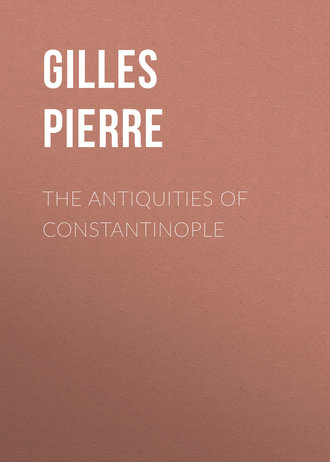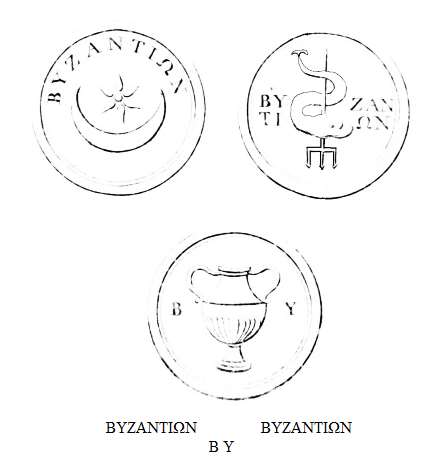 полная версия
полная версияThe Antiquities of Constantinople
It has five Palaces.] Old Rome, instead of these, has one Thousand one hundred and eighty Houses.
Fourteen Churches.] Rome had four Hundred and twenty four Temples.
Five divine Houses of the Augustæ, and of those who bore the Title of the Most Illustrious three.] The Houses of those Ladies, who bore the Title of Augustæ were called Divine. They had also other Marks of Imperiality and Honour conferr’d upon them. By the Mistake of the Writer these Houses were reckoned six, though they were no more in Number than five only, viz. two of Placidia, two of Pulcheria, and one of Eudocia, the Wife of Theodosius. As to the Houses belonging to the Ladies, entitled the Most Illustrious, one of them belonged to Marina, and the other two to Arcadia, and bore the same Title with themselves.
Eight Bagnio’s.] Victor writes, that at Rome there were eleven.
Two Basilica’s.] There were ten of them at Rome.
Four Fora’s.] At Rome there were eleven; Victor says nineteen.
Two Senate-Houses.] At Rome, as Victor says, there were three; one stood between the Capitol, and the Forum Romanum, where was the Temple of Concord; another by the Porta Capena, and a third in the Temple of Bellona, which stood in the Circo of Flaminius, where the Foreign Ambassadors resided, because they would not allow them Admittance into the City.
Five Granaries.] At Rome there were two hundred and ninety two.
Two Theatres.] At Rome there were three.
Two Lusoria.] At Rome, according to Victor, there were sixteen.
Four Havens.] At Rome there was but one.
One Circo.] At Rome there were two.
Four Cisterns.] At Rome there were none.
Four Nymphea.] At Rome there were fifteen.
Three hundred and twenty two Streets.] At Rome four Hundred and twenty four.
Four Thousand three hundred and eighteen large Houses.] At Rome there were forty six Thousand six hundred and two Insulæ, and one Thousand seven hundred and eighty large Houses. The Houses here mentioned were large roof’d Buildings, tyl’d at Top four Ways; the Insulæ were roof’d Buildings, tyl’d only before and behind.
Forty two Portico’s.] At Rome there were six only.
A hundred and fifty three private Baths.] At Rome there were eight hundred and fifty six.
Twenty publick, and a hundred and twenty private Mills.] At Rome two hundred and fifty four.
A hundred and seventeen Gradus.] At Rome none.
Five Flesh-Markets.] At Rome two only.
Five hundred and sixty Collegiati.] It is apparent that thirty seven of them are omitted in the last Ward. There was no such Office at Rome, yet there were, instead of them, Watchmen divided into seven Companies, whose Business, according to Dion and Suetonius, was much the same with that of the Collegiati.
Sixty five Vico-magistri.] It should be read seventy; for five of them are omitted in the last Ward. At Rome the Number of Collegiati was six hundred and seventy two.
A Porphyry Pillar.] There was no such Pillar, as Cedrinus says, at Rome, tho’ this was brought from thence. Gyllius writes, that this Pillar was made of square marble Stones, and that it stood in the Hippodrom.
Two Pillars with Winding-Stairs in the Inside of them.] There was the same Number at Rome.
One Colossus.] At Rome there were two. ’Tis omitted in the Description of the Wards, as many other Things of Note are.
The Golden Tetrapylum.] Gyllius quotes an unknown Author who will have this Tetrapylum to have been a Quadrangle with Portico’s round it, having Four Gates, and was formerly call’d Quadrivium. The Latines call it a Stadium. But there’s no such Place to be found in the Wards of the City, unless it be the Stadium in the Fourth Ward, which is omitted in the Summary View of the City. Cedrinus, in his Life of Leo Magnus, mentions this Tetrapylum. Evagrius in the twenty eighth Chapter of his third Book tells us, that it was built by the Senator Mammianus, in the Reign of Zeno. He built, says he, two stately Portico’s of exquisite Workmanship, and beautify’d them with a neat glossy Marble. As to the Tetrapylum built by Mammianus, there are not, as Gyllius tells us, the least Remains of it. Victor writes, that there was a Pentapylum in the tenth Ward of Rome.
The Augusteum.] This was the Forum of Augustus.
The Capitol.] At Rome, as Victor writes, there were two; the old and the new Capitol.
The Mint, or Treasury.] There was no such Place at Rome.
Three Gradus by the Sea-Shore.] There were no such Stairs at Rome, yet they had their Lakes, their Naval Fights, &c.
The City is reported to have had twenty three Gates. Laonicus Chalcondylus, in his History of the Ottomans, tells us, that Constantinople contains in compass a hundred and eleven Furlongs, which is more than thirteen Italian Miles. ’Tis generally thought to be eighteen Miles in Circumference. Besides the foremention’d Curiosities, Constantinople has been famous for the Aqueduct of Hadrian, which furnish’d the Palace, the Nymphea, and the Bagnio’s with a Sufficiency of Waters, as Theodosius mentions in a Letter to Cyrus, Prefect of the City. The Bagnio’s of Achilles are also mention’d by him, where he says, that these Bagnio’s were supply’d with Water convey’d into them from the said Aqueduct by leaden Pipes. Cedrinus says, that these Bagnio’s were built near the Strategium, and took their Name from an Altar, which was dedicated to Ajax and Achilles: And Cassiodorus relates, that the Fire, which happen’d in the Reign of Constantine the Great, burnt down the City, as far as the Bagnio’s of Achilles.
Some Account of the Suburbs as they are mention’d in the Codes and Law-Books
Procopius tells us, in his first Book de Ædif. Justin. that the Hepdomum was one Part of the Suburbs of Constantinople. Justinian, says he, built another Church dedicate to St. Theodora in a Place call’d the Hepdomum, which in the Greek signifies the Seventh. Zonaras, in the Life of Phocas, mentions the same Thing, as does also Cedrinus in the Life of Arcadius and Justin, with many others. In this Place were many Laws enacted; and Zonaras writes, that Theodosius the Great built a Church there, in Honour of St. John Baptist. Gyllius says, that ’tis at present enclos’d within the Walls of the City, that it stands upon the sixth Hill, and that ’tis call’d Hepdomum, or Seventh, as denoting the Number of the Suburbs of the City.
The Blachernæ.] This is another Part of the Suburbs, mention’d by Justinian in his 151st Nov. where he says, that Hierius bequeath’d by Will to his Son Anthemius the Suburbs in the Blachernæ. Zonaras writes, that Pulcheria, the Sister of Theodosius the Less, built a Church to the Blessed Virgin in this Place, which, as Procopius tells us, was repair’d by Justinian. Cedrinus observes, that the Emperor Justin, Nephew of Justinian, enlarg’d it with two Arches. Suidas reports, that Anastasius the Emperor built there a large Triclinium and Tiberius a Bagnio, as Zonaras writes. It took its Name of the Blachernæ, as Gyllius believes, upon the Authority of Dionysius a Byzantian Writer, from some Person, who was formerly a kind of a petty King there. It was situate near the Sea, in the Place, as Nicephorus observes in his 15th Book Chap. 25th of his Eccl. Hist. where Leo the Great built a Church to the Virgin Mary.
The Monastery of Studius was another Part of the Suburbs of Constantinople, in which, as Justinian observes, in his 6th Chap. Novel 59th. was kept a large Bier, for the Burial of the Dead. The following Account is given of Studius by Nicephorus, in his 15th Book, Chap. 25th of his Eccles. Hist. An eminent Citizen of Rome, says he, nam’d Studius, came from thence to Constantinople, where he built a Church to the Memory of St. John Baptist, and that divine Service might be celebrated there with more Decency and Solemnity, he took some Monks out of the Monastery of the Ἀκοίμητοι, who were so call’d, because some of them were always waking to attend divine Worship. The heavenly-minded Marcellinus built them a Monastery, in which they continually sang Hymns to God, their Society being divided into three Tribes for that Purpose. Thus far Nicephorus. Upon this Occasion Studius was made Consul, as appears by an Inscription over the Gate of his own Monastery, which runs thus:
This Pyle was rais’d by Studius’ bounteous Hand:Great Actions greatest Honours should command.In just Acknowledgment, the grateful Town,Repay’d the Founder with a Consul’s Gown.This happen’d in the Reign of Leo the Emperor.
The Coparia, as is plain from the 159th Nov. of Justinian, was another Part of the Suburbs, and was bequeath’d, as appears by the Codicil of Hierius’s Will to his Niece.
There was also another Part of the Suburbs in the Promontory of the Creek of Sosthenium, which was formerly in the Possession of Ardaburus, General of the Army to Theodosius the Less. The Right of it afterwards came to Hierius, who was Præfectus Prætorio, or General of the Life-Guard to the Emperor Zeno. Nicephorus in the 50th Chap. of his 7th Book of Eccl. Hist. gives this Reason why it was call’d Sosthenium, ’Tis recorded, says he, that the Argonauts of Greece, when they arriv’d here, began to plunder the Countrey, but were defeated by Amycus, who was then Governor of the Place, and being dispers’d, they wander’d about till they came to a woody unhospitable Place, where they took shelter in a large Thicket of Trees; that in this Calamity Virtue came down to them from Heaven in a human Shape, having Wings like an Eagle, and by her Oracle foretold, that if they would venture another Battle, they should conquer Amycus. Directed by this Advice, they engag’d them again, obtain’d an entire Victory over them, slew him, and all his Forces; and that to express their Gratitude to the Vision, they built a Temple, and erected a Statue to her, in the Shape she appear’d to them, which gave the Place the Name of Sosthenium, because they secur’d themselves by the second Battle.
Bytharium, or Philotheum.] This was also another Part of the Suburbs, and is mention’d as such in 159th Nov. of Justinian.
The Porta Veneta is mentioned by Procopius in his History of the Persian War; who, speaking of some military Officer, tells us, that when he came to the Porta Veneta, which stands on the Right Hand of the Palace, he halted and determin’d to march to Hypalium. This Gate seems to take its Name from the Suburbs call’d in Venetis, probably because the Venetian Faction, a Company of Chariot-Racers dress’d in Sky-colour’d Cloths, dwelt there.
Procopius also takes Notice of the Pontichium by the Ferry, and also of the Rusiniana, as two other Parts of the Suburbs. These Places he mentions in his 1st Book of the Persian War; as does also Sozomen in the 21st Chap. Book the 8th.
Of the present Buildings of Constantinople
Gyllius assures us, that the whole City, at present, is under a visible Decay, as to its Buildings; that the Houses are low and mean, and that there’s little or nothing to be seen of its ancient Beauty and Magnificence, except in a few of their Basha’s Houses, their Mosques, their Bagnio’s, and their Caravansera’s, which are all very noble Buildings, and are as follows.
There are at least three hundred Mosques built with Marble, cover’d with Lead, and shining with glossy marble Pillars.
There are above a hundred publick Bagnio’s, both for Men and Women, which are very spacious.
There are also about the same Number of Caravansera’s; the most eminent of which are adorn’d with Fountains, which are constantly supply’d with Water from the Fields adjoining the Suburbs, and which also supply the whole City.

1
The Society of Antiquaries in London.

